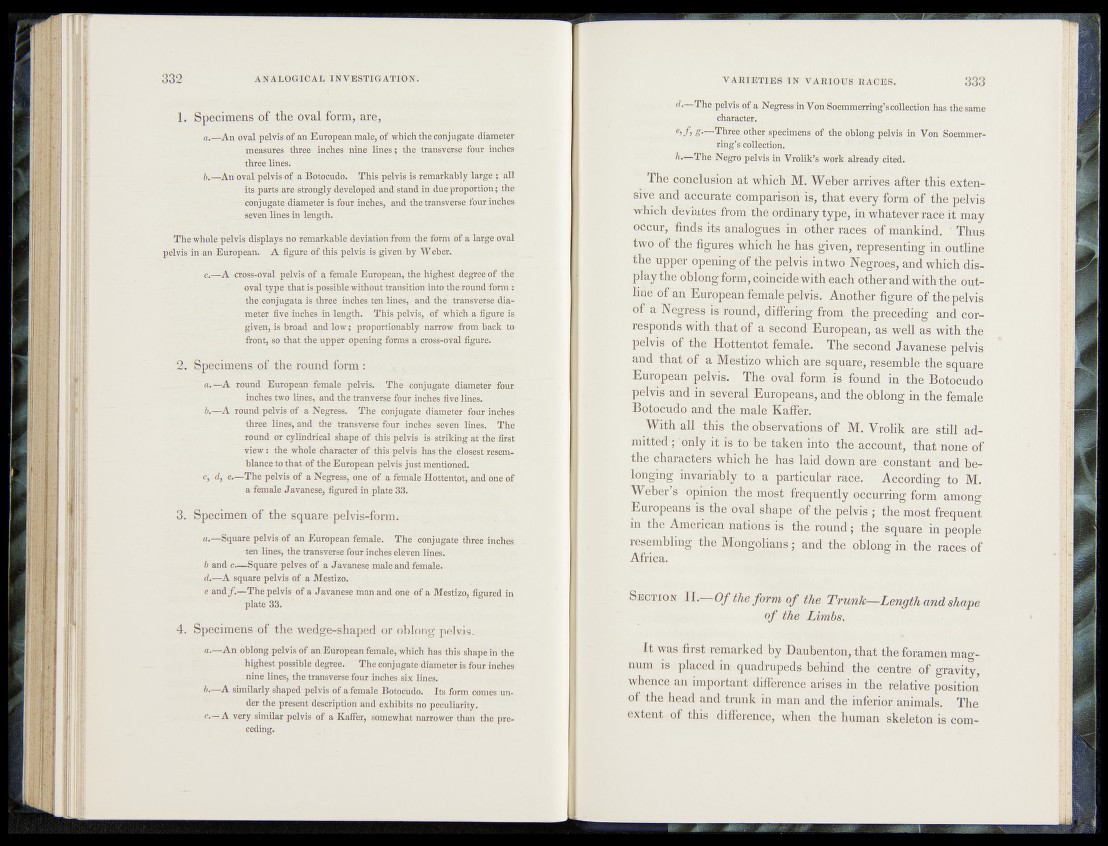
1. Specimens of the ovahfqrm, are,
a. —An oval pelvis of an European male, of which the conjugate diameter
measures three inches nine lines; the transverse .four inches
three lines;
b. —A n ova! pelvis of a Botocudo. This pd!vis. is remarkably large; all
its parts are strongly developed and stand in due proportion; the
— conjugate diameter is four inches, and the transverse .four inches
- seven lines in length, f
The whole pelvis displays no remarkable deviation from the form of a large oval
pelvis in an European. A figure of this pelvis is given by Weber.
- c.—A cross-oval pelvis of a female European, the highest degree of the
oval type that is possible without transition into the round form:
the conjugata is three inches ten lines, and the transverse diameter
five inches in length. This pelvis, Of which a; figure is
. given, is broad and low; proportlonably narrow—from back to
front, so that the upper opening forms a. cross-oval figure.
2. Specimens of .the round form: '
a , —A round European female pelvis. The conjugate diameter four
inches two lines, and the tranvereeTpur inches fiye linesf .
b. —A round pelvis of a Negress. The conjugate diameter four inches
three lines, and the transverse four inches seven lines. The
round or cylindrical shape of this pelvis is striking at the first
view: the whole character of this pelvis has the closest resemblance
to that of the European pelvis just mentioned. •
~ c, d, e.—The pelvis of a Negress, one of a female Hottentot, and one of
a female Javanese, figured in plate 33.
3. Specimen of the square pelvis-form;
a.—Square pelvis of an European female. The conjugate'three inches.
. ten lines, the transverse four indies eleven lines.
J> and c—-Square pelves of a Javanese male and female.
;—d.—A square pelvis of a Mestizo.
e a n d /.—The pelvis of a Javanese man and one of a Mestizo, figured in
plate 33.
4. Specimens of the wedge-shaped or oblong pelvis.
a-—An oblong pelvis of an European female, which has this shape in the
highest possible degree. The conj ugate diameter is four inches
• nine lines, the transverse four inches six lines.
b>—A similarly shaped pelvis of a female Botocudo. Its form copies under
the present description and exhibits no peculiarity.
- c-—A very similar pelvis of a Kaffer, somewhat narrower than the preceding.
df^vThe pelvis of a Negress in Von Soemmerring’s collection has the same
character. .
i Three other^'specimens .of the Oblong pelvis in Von Soemmer-
>- Negm^pojvi^infiVrolik^ work already cited; 1
The col/cfffitpn Weber ^arrives after this extensive
anff a c c h r a |^ that P:CTvform of the pelvis
which ctefktes from^i? ordinary type* 'in whatever race it may
occur, finds its analj^ ^ S in othlr races ot mankind. Thus
two of the f i^ r® which'he^lhs repreg^ting-fm^outfiiie
the upper o p e n i n g ^ o f i h ' I ^ J ^ e f f e c s , and which dis-
playthe'obl QBg foiffiffii ncid^ with/S^- other a | J wath the out-
l j |B B an EurbpChn'feniale p e l^ f^ h pM p 'fig u re ip^the pelvii*
_ . ■ round, diff^mg”from th^irbe'eding and Cor-.
rCsppnds wd^jihal of European,1 as?swellfas with the
H B B ^ e^ g ^ tten to t fShiafel The s(^qhd;!Ja\Ymese pelvis
hM^that of “a Mestizo which are'sqWe, roscml|te;t$e square
European pe}f is: The oval form is found in tie'Botocudo
pelvis and in several the female
Botocudo and A® male Kaffer.
With all ihis t^ d b fe c ^M m ^ of M. Vrolik are still admitted
,* rCnly it‘ is to be'taken' inl$; the'accohijt, that none of
the ch^rahtCrs whiS he has’laid dowffai§F^cmst'ant and be-
l9ng ||g invariably to a particular to M.
Weber’s opinion the^^^p^ frequently occurring form among
Europea/ni ip the oval shape' pf the pelvis • the most frequieht
m the American nations is the round; the square in people!
resembling the Mongolians; and the oblong in the races of
Africa.
Section I I .—O f the form o f the T ru n k—Length and shape
o f the, fimbs.
I t was first remarked by Daubenton, that the foramen magnum
is placed in quadrupeds behind the centre of gravity,
whence an important difference arises'in the relative position
of the head and trunk in man and the inferior animals. The,
extent-of this difference, when the human skeleton is com